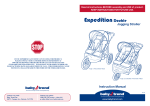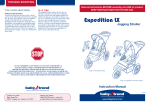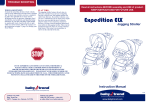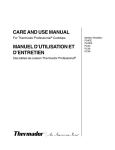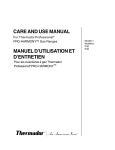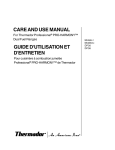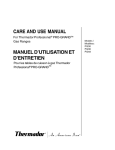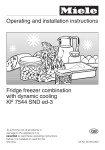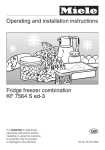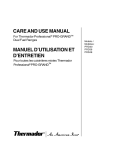Download Baby Trend Inertia Grey Owner`s manual
Transcript
WARNING Carefully read and understand all instructions and warnings in this manual. Failure to properly use this Infant Car Seat increases the risk of SERIOUS INJURY or DEATH in a sudden stop or crash. KEEP INSTRUCTIONS FOR FUTURE USE. Store this manual in the pocket provided on the back of the seat. Infant Car Seat STOP If you experience any difficulty in using this product, please contact our customer service department at 1-800-328-7363 between the hours of 8:00 A.M. and 4:30 P.M. Pacific Standard Time for assistance. Please have your model number and manufacturing date available when you call. This information can be found on a small sticker on the bottom of the product. OWNER’S MANUAL Para instrucciones en Español, conéctese a www.babytrend.com o llamar al: 1-800-328-7363. Convenience through innovation and thoughtful design Baby Trend, Inc. 1607 S. Campus Ave., Ontario, CA 91761 1-800-328-7363 (8:00am ~ 4:30pm PST) www.babytrend.com CS0301A0113 Convenience through innovation and thoughtful design www.babytrend.com Copyright © 2013, Baby Trend, Inc. E32IN0113U Table of Contents Table of Contents 1.0 General Warnings...........................................................................3 2.0 Registration Information................................................................6 3.0 Features and Benefits....................................................................7 3.1 Adjustable Back WITH Harness System................................................ 7 3.2 Base..................................................................................................... 12 4.0 Preparing Car Seat for Use..........................................................14 4.1 Assembling the Car Seat..................................................................... 14 5.0 Height and Weight Limitations....................................................15 6.0 Important Safety Information......................................................16 6.1 About your child .................................................................................. 17 6.2 About your vehicle................................................................................ 17 6.3 About this Car Seat.............................................................................. 18 6.4 About use as a carrier.......................................................................... 20 7.0 LATCH Attachment System.........................................................22 8.0 Selecting a Vehicle Seat Location...............................................23 8.1 Overall Considerations in Selecting a Location................................... 23 8.2 Check that the Vehicle Seat Meets the Following Requirements....................................................................................... 25 9.0 Vehicle Seat Belts.........................................................................26 9.1 SAFE Vehicle Seat Belt Systems......................................................... 26 9.2 Locking Clip Installation....................................................................... 29 9.3 UNSAFE Vehicle Seat Belt Systems................................................... 30 10.0 Securing Car Seat in Your Vehicle..................................................32 10.1 Preparation for Installation in Vehicle................................................. 32 10.2 Base Installation with LATCH System................................................ 33 10.3 Base Installation with Vehicle Belt..................................................... 35 10.3.1 Initial Positioning............................................................................. 36 10.3.2 WITH Vehicle Lap/Shoulder Belt..................................................... 37 10.3.3 WITH Vehicle Lap Belt only............................................................ 37 10.3.4 Tighening Vehicle Seat Belt............................................................ 37 10.4 Adjust Base Recline into Desired Position......................................... 39 10.5 Attach Car Seat to Base..................................................................... 40 10.6 Car Seat Only Installation without Base............................................. 41 10.6.1 Initial Positioning............................................................................. 41 10.6.2 WITH Vehicle Lap/Shoulder Belt..................................................... 42 10.6.3 WITH Vehicle Lap Belt only............................................................ 42 10.6.4 Adjust Seat Recline Angle............................................................... 43 10.6.5 Tighening Vehicle Seat Belt............................................................ 44 11.0 Securing Child with Harness System..................................................45 11.1 Securing Your Child with Harness System......................................... 45 11.2 Adjusting Harness Strap Height......................................................... 50 11.3 Adjusting the Crotch Strap Length..................................................... 51 12.0 Final Safety Check......................................................................52 13.0 Additional Information...............................................................53 13.1 Care & Maintenance.......................................................................... 52 13.2 Using Your Car Seat with a Baby Trend Stroller................................ 55 Airplane Use.............................................................................................. 56 Replacement Parts ................................................................................... 56 1 2 1.0 General Warnings 1.0 General WARNINGS TO PARENTS AND CAREGIVERS WARNING Proper use is required! Even if using this car seat seems easy to figure out, it is very IMPORTANT TO FOLLOW THE INFANT CAR SEAT AND VEHICLE OWNER’S MANUALS! •Failure to follow these instructions and Car Seat labels can result in a child striking the vehicle’s interior during a sudden stop or crash. - Your child’s safety depends on proper installation and use of this car seat. Read and understand all information in this owner’s manual and product labels before using this car seat. - Improper use of the car seat can result in serious injury or death from a sudden stop or crash. •DO NOT use accessories or parts other than those provided by Baby Trend. Use of accessories or parts from other manufacturers could alter the performance and safety of the car seat. •DO NOT use this car seat if it has been in a crash, it must be replaced. A crash can cause unseen damage and using it again could result in serious injury or death. •DO NOT use car seat if it is damaged or missing parts. No car seat can guarantee protection from injury in every situation, but proper use helps reduce the risk or serious injury or death. 3 Warnings The ultimate safety of your child depends on the proper and secure installation of the Car Seat in your vehicle. Proper installation requires that you read and understand this entire manual and your vehicle’s owner’s manual before placing your child in the seat. DO NOT allow others to install or use this Car Seat unless they completely understand its proper installation and use. Your child’s safety depends on you: 1. Choosing the best location within your vehicle for the Car Seat. Seating positions with Active Frontal Air Bags must be avoided. 2. Adjust the harness shoulder strap height to be at or just below the top of your child’s shoulders. 3. Adjust harness length to snugly adjust the harness straps around your child. 4. This Car Seat is ONLY to be used in a vehicle in the rear-facing position. 5. Proper use and routing of the seat belts in your vehicle is essential for proper installation. 6. LATCH must be secured or vehicle seat belt must be tightly adjusted and stay tightly adjusted around car seat. 4 1.0 General Warnings 2.0 WARNING Proper recline angle for seat back recline is required. Follow the instructions for adjusting recline angle using car seat with base and using without base. - Too upright can cause a young infant’s head to fall forward and restrict breathing. - Too reclined can cause ejection in a sudden stop or crash. When using the car seat WITH the base, always adjust the base recline into the most reclined position, position #1, for children under 3 months of age or unable to hold head up unassisted. For infants that can hold their head upright unassisted, any of the four base recline adjustment positions may be used. When using the car seat WITHOUT the base, follow the instructions and use the Seat Angle Indicator on the side of the car seat to adjust the seat recline angle. 5 Registration Information REGISTER YOUR CAR SEAT Please complete the following information. The model number and manufactured in (date) can be found on a label on the bottom of the Car Seat. Model Number: ___________________ Manufactured in: __________________ Purchase Date: ___________________ Please fill out the prepaid registration post card attached to the straps and mail it today. Child restraints could be recalled for safety reasons. You must register this restraint to be reached in a recall. Send your name, address, email address if available, and the restraint’s model number and manufacturing date to: Baby Trend, Inc., 1607 S. Campus Avenue, Ontario, CA 91761 or call 1-800-328-7363 or register online at: http://www.babytrend.com/ registration.html. For recall information, call the U.S. Government’s Vehicle Safety Hotline at 1-888-327-4236 (TTY: 1-800-424-9153), or go to http://www.NHTSA.gov. If You Need Help Please contact our Customer Service Department with any questions concerning your child restraint. When you contact us, please have the model and manufactured in (date) ready. The model number and manufactured in (date) can be found on a white label located on the bottom of the car seat. USA Toll Free: 1-800-328-7363 8:00 a.m. to 4:30 p.m. (PST) Monday - Friday or www.babytrend.com 6 3.0 Features and Benefits 3.0 Features and Benefits 3.1 Adjustable Back WITH Harness System Harness Slots Carry Handle Canopy Adjustable Back Seat Pad Canopy Adjuster Knob Seat Angle Indicator Handle Release Button Harness Straps Harness Clip Buckle Vehicle Belt Path/Hook without base Locking Clip (stored on side of seat pad) Harness Adjuster Strap Harness Belt Owner’s Manual Holder Base/Stroller Hook Belt Adjuster Plate Harness Adjuster Strap Lock Bar Harness Adjuster Button 7 8 3.0 Features and Benefits 3.0 Features and Benefits Carry Handle Build-in Safety Harness The Carry Handle has four positions: the Carry position, a MidStorage position, a Storage position and the Non-Rocking position. Front adjust 5-point Safety Harness, adjust the harness with a push of a botton. 5-Point Harness Crotch Strap Carry Mid-Storage Storage To adjust handle: •Depress the two buttons located on the handle just above the connection to the Car Seat shell to release the handle. •Slowly rotate the handle to the desired position. The buttons should pop out and the handle should automatically lock into the new position. (Fig. 9-1) •Before lifting the Car Seat, push on the handle to check that both sides of the handle have locked into carry position. •Use the Storage or Non-Rocking position when the Car seat is in the vehicle. 9 The crotch strap is adjustable in length to ensure a safe and comfortable fit for harness. Non-Rocking Locking Clip The Locking Clip is stored under the seat pad on the right side of the Car Seat and is used to securely install the Car Seat with certain types of vehicle lap/shoulder combination belts. 9-1 Locking Clip 10 3.0 Features and Benefits 3.0 Seat Angle Indicator Features and Benefits 3.2 Base The Seat Angle Indicator is used to ensure that the seat is installed at the proper degree of recline when used without the base to adequately protect your child in a crash. Attachment Locks Base Recline Adjustment Handle Use Seat Angle Indicator to adjust seat recline ONLY when installing car seat WITHOUT Base. LATCH Connectors Seat Angle Indicator Belt Adapter Belt Path for Vehicle Belt Installation Base Recline Adjustment Indicator 11 12 3.0 Features and Benefits 4.0 Your Car Seat base can be installed with either the LATCH attachment system or with vehicle belt. When available, LATCH is the recommended method of securing the Car Seat in the vehicle. Vehicle Beth Path 4.1 Assembling the Car Seat Attaching the Canopy Slip the canopy stays through the sleeves on the canopy. Vehicle Belt Path Latch Connectors LATCH relese button Preparing Car Seat for Use Latch Connectors The canopy is attached by inserting the ends of the canopy plastic stays into the female fittings found on the inside of the handle hub. Base Recline Adjustment Indicator The Base has 4 adjustable recline positions. Base Recline Adjustment Handle The Base Recline Adjustment Handle raises and lowers the rear of the Base in order to obtain the proper angle of recline for proper installation of the Car Seat when using the Base. 13 Base Recline Adjustment Indicator Adjustment Handle 14 5.0 Height and Weight Limitations WARNING! DEATH or SERIOUS INJURY can occur - Proper use is required Your child must meet ALL these requirements: •Weight between 5 and 32 lbs (2.2 and 14.5 kg) •Height is 32 inches (81.3 cm) or less •The Harness Straps must be at or just BELOW child’s shoulders when in highest adjustment position 15 6.0 Important Safety Information WARNING! DEATH or SERIOUS INJURY can occur: Failure to follow these instructions and Car Seat labels can result in child striking the vehicle’s interior during a sudden stop or crash. •Proper installation of the Car Seat in your vehicle and proper securing of your child in the Car Seat are essential to ensure the safety of your child. Your child can be injured in a sudden stop or crash if not properly secured in the Car Seat or if the Car Seat is not properly installed in the vehicle. •Use only in a rear-facing position when using Car Seat in a vehicle. •Children have STRANGLED in loose or partially buckled harness straps. Fully restrain the child even when carrier is outside the vehicle. •Secure this child restraint with the vehicle’s child restraint anchorage system if available or with a vehicle seat belt. •Never put a Car Seat in a vehicle front seat location unless specifically recommended in vehicle owner’s manual. •Do not place this restraint in a vehicle seat that has an active frontal air bag. If a frontal air bag inflates it can hit the Car Seat with great force and cause death or serious injury to your child. •This Car Seat is designed and tested to accommodate a child of a specific range of WEIGHT and HEIGHT. Using the Car Seat for a child whose weight or height is outside of these limits will increase the risk of death or serious injury in the event of a sudden stop or crash (see Section 5.0 of this manual for WEIGHT and HEIGHT limits for this car seat). 16 6.0 Important Safety Information •DO NOT use accessories or parts other than those provided by Baby Trend, Inc. Use of accessories or parts from other manufacturers could alter the performance and safety of the Car Seat. •This Car Seat is certified for use in Motor Vehicles and Aircraft and conforms to all applicable Federal motor vehicle safety standards. •This Car Seat is certified for use on Aircraft WITHOUT the Base. No car seat can guarantee protection from injury in every situation, but proper use helps reduce the risk of serious injury or death. 6.1 About your child •Special needs children, such as pre-term babies, may suffer difficulties in using this Car Seat. The seat recline angle in this Car Seat may not be appropriate for Special Needs babies. If your child has special needs or any breathing difficulties, please discuss your child’s needs and travel in Car Seats with your pediatrician, or other competent health care provider, to ensure the safety of your child. •DO NOT dress your child in bulky clothing or other garments that will hinder the harness from being properly latched between your child’s legs and belts being snugly adjusted around your child. •Never leave your child unattended, even for a moment. 6.2 About your vehicle •Proper installation of the Car Seat in your vehicle and proper securing of your child in the Car Seat are essential to ensure 17 6.0 Important Safety Information the safety of your child. Quick turns, sudden stops, or other maneuvers in avoiding a crash, as well as a crash, can injure your child if not properly secured in the seat or if the seat is not properly installed in the vehicle. - LATCH attachment must be secured or vehicle seat belt must be tightly adjusted and stay tightly adjusted around car seat. - Harness must be snugly adjusted around your child. •Not all vehicle seat belts or seating locations can be used with this Car Seat. Read vehicle owner’s manual and “Vehicle Seat Belts” section in this manual. •Some vehicles do not have any safe location where this Car Seat to be securely installed. In addition, many vehicles do not have seat belt systems that will adequately hold this Car Seat in the required position. Please refer to both this manual and your vehicle owner’s manual for complete information for proper, safe installation of this Car Seat. 6.3 About this Car Seat •This Car Seat is constructed of plastic that can deform over time if left with any object in the seat while stored. DO NOT leave heavy objects in the Car Seat while not in use. DO NOT store the seat in the trunk of your car with heavy objects on it or with pressure on the Car Seat from the trunk lid. •Replace the Car Seat and Base after a vehicle crash of any kind. A crash, even a minor crash, can cause undetectable damage to the Car Seat or Base that may cause the Seat or Base to fail in a subsequent crash. DO NOT use the Car Seat if it is damaged or broken. 18 6.0 Important Safety Information •DO NOT use Car Seat if it is damaged or is missing parts. •Never combine this Car Seat or Base with any other Car Seat or Base from any other manufacturer. If you are in need of an additional Base, please contact your local dealer or Baby Trend to obtain one. •Never leave the Car Seat or Base unsecured in your vehicle even when not occupied. An unsecured seat or base can fly through the vehicle in the event of a crash, sudden stop or sharp turn and cause serious injury to the driver, who may then loose control of the vehicle, or to other passengers. When not in use, either remove the seat and or base from the vehicle or make sure that both are securely belted to the vehicle according to these instructions. •The Car Seat may become very hot if left in direct sunlight. Your child may suffer burns from hot components. Always check the Car Seat for hot surfaces that may come into contact with your child before placing your child in the Car Seat. We suggest that you cover the Car Seat with a blanket or towel if it will be subject to direct sunlight while you are away from the vehicle. •Discontinue use of the Car Seat and Base after six (6) years from the date of manufacture. The date of manufacture can be found on the label located on the underside of the Car Seat or Base. When discarding an out of date seat, please ensure that someone finding the seat will be unable to use it. We suggest that you disable the seat by removing the pad and harness and discarding the pieces at different times. 19 6.0 Important Safety Information 6.4 About use as a carrier WARNING Never leave child unattended. SUFFOCATION HAZARD: Infant carrier can roll over on soft surfaces and suffocate child, NEVER place carrier on beds, sofas, or other soft surfaces. STRANGULATION HAZARD: - Child can strangle in loose restraint straps. Never leave child in carrier when straps are loose or undone. - Children have STRANGLED in loose or partially buckled harness straps. Fully restrain the child even when carrier is used outside the vehicle. FALL HAZARD: Child’s movement can slide carrier. Never place carrier near edges of counter tops, tables, or other elevated surfaces. Never Leave Your Child Unattended, even if they are asleep. Very often when you arrive at your destination you will find that your child has fallen asleep in the Seat. Do not leave the child unattended, even for a minute. Your child can tip or move the carrier by their movements, kicking or grabbing on to their surroundings. If the carrier tips over, your child can suffocate from the surface that the seat is on as well as from the pressure on their chest from the safety harness. In addition, if the carrier is placed too upright, the child’s head can fall forward and cause the child to have difficulty breathing. 20 6.0 Important Safety Information WARNING! To avoid death or serious injury from suffocation, falls and other hazards: •Always place the carrier on a firm and level surface. Never place the carrier on soft or plush surfaces such as a bed, comforter, couch, sofa, chair, etc. The carrier has a very high possibility of tipping over if placed on a soft or plush surface. •Fall hazard: Child’s movements can slide carrier. Never place the carrier near the edge of high surfaces such as tables, counter tops, shelves, or other elevated surfaces. To prevent falls, stay within arm’s reach whenever the carrier is not on the floor or ground. •Child can strangle in loose safety harness straps. Never leave child in carrier when straps are loose or undone. Always use the safety harness as instructed in this manual when the child is in the carrier. •Before lifting the carrier with the handle, check that the handle is firmly locked into position. The carrier will pivot about an unlocked handle and can result in injury to your child. •Strings and cords can cause strangulation: - DO NOT place items with string around a child’s neck, such as hood strings, pacifier cords, etc. - DO NOT suspend strings on or over carrier. - DO NOT attach strings to toys. - DO NOT place the carrier near a window where cords from blinds or drapes can strangle a child. •Carrier use: - Rocker use: Handle in mid-storage or storage position. - Non-Rocking use: Handle in non-rocking position. 21 7.0 LATCH Attachment System LATCH ATTACHMENT SYSTEM Lower Anchors and Tethers for Children (LATCH) System is designed to make installation of child Car Seats in motor vehicles easier by requiring child restraints to be installed without using the vehicle’s seat belt system. Since September 1, 2002, at least two rear seating positions of all cars, mini vans and light trucks come equipped LATCH systems which include lower child restraint anchor points located between a vehicle’s seat cushion and seat back, and top tether anchors. Also on September 1, 2002, all child restraints will have two attachments which will connect to the vehicle’s lower anchor points and top tethers (on forward-facing car seats). Together, the lower anchors and upper tethers make up the LATCH system. Read your vehicle owner’s manual for exact locations, identification and requirements for use with a child restraint. ONLY use LATCH to secure your child Vehicle Top restraint in a seating position recommended Tether Anchors by the vehicle manufacturer. Refer to the vehicle owner’s manual for the vehicle’s top tether anchor locations. They should be identified by one of the symbols shown in Fig. 22-1. Latch Lower Anchors 22 22-1 8.0 Selecting a Vehicle Seat Location SELECTING THE BEST VEHICLE LOCATION WARNING! DEATH or SERIOUS INJURY can occur: • IMPROPER PLACEMENT OF THE CHILD RESTRAINT INCREASES THE RISK OF SERIOUS INJURY OR DEATH. WARNING Not every location within an automobile may be safe for the installation of this Car Seat. Car Seat must be tightly secured and remain tightly secured at all time. Some automobiles have no seating position installation of a Car Seat. Improper placement or use of a car seat that is not tightly secured in a vehicle will increase the risk of death or serious injury. Please follow the instructions in this manual and in your vehicle owner’s manual carefully to ensure proper location and installation of this Car Seat. If you are uncertain about the proper location of the Car Seat within the vehicle, contact your vehicle manufacturer directly or through their dealer before using this Car Seat. You are also invited to call Baby Trend at1-800328-7363 for additional information or assistance. 8.1 Overall Considerations in Selecting a Location •According to accident statistics, children are safer when properly restrained in rear vehicle seating positions, rather than front seating 23 8.0 Selecting a Vehicle Seat Location positions. Whenever possible, this Car Seat should be secured in the rear center, seating position. The rear seat directly behind the front seats NOT in a third row rear seat. (Fig 24-1) 24-1 •ONLY place in a forward-facing vehicle seat. DO NOT place this Car Seat in any vehicle seat that faces to the rear. (Fig 24-2) •DO NOT place this Car Seat in any vehicle seat that faces to either side of the vehicle. (Fig. 24-3). 24-2 •We recommend that you use the center rear seat position as the safest location for the Car Seat. In addition, whenever possible, have an adult ride in the rear with the child in order to monitor the child. Note: LATCH system may not be available in the center rear seat position. Install 24-3 with a vehicle seat belt if LATCH is not available. •If the driver is the only adult in the vehicle and the child requires constant monitoring, then a vehicle front seating position may be used if there is no passenger side Active Air bag and all of the following requirements are met for this location. 24 8.0 Selecting a Vehicle Seat Location 8.2 Check that the Vehicle Seat Meets the Following Requirements WARNING DO NOT place rear-facing child seat on front seat with air bag. DEATH OR SERIOUS INJURY can occur. The back seat is the safest place for children 12 and under. •NEVER place this Car Seat in a vehicle seating location that has an Active Air Bag! Active Air Bags inflate with great force! An inflating Air Bag can strike a Car Seat with enough force to cause death or serious injury to your child. If your vehicle is equipped with a front passenger side Active Air bag, please refer to the vehicle’s owner’s manual for additional information about Active Air bags and child Car Seat installation. •DO NOT use this Car Seat in a vehicle that has a vehicle seat back that does not lock into place. A seat back that folds forward must have a latch or locking mechanism to prevent it from flying forward and striking the child in a sudden stop or accident. •Please review your vehicle owner’s manual to determine the best location for the Car Seat or to determine if any locations are unsafe for Car Seat installation. If you do not have the vehicle owner’s manual 25 9.0 Vehicle Seat Belts or the owner’s manual does not address child Car Seat installation, please contact the vehicle manufacturer to obtain this information before using this Car Seat. VEHICLE SEAT BELT REQUIREMENTS WARNING! DEATH or SERIOUS INJURY can occur: THE CAR SEAT MUST BE TIGHTLY SECURED BY THE VEHICLE SEAT BELT AT ALL TIMES. A VARIETY OF VEHICLE SEAT BELT SYSTEMS ARE AVAILABLE IN VEHICLES. SOME OF THESE VEHICLE SEAT BELT SYSTEMS ARE NOT SAFE FOR USE WITH THE CAR SEAT. Even newer vehicles can have seat belts systems that are NOT safe for use with the Car Seat. These systems may look safe but their method of operation precludes their use with the Car Seat. If you are unsure if the vehicle seat belt is safe for use with the Car Seat, check the vehicle owner’s manual or contact the vehicle manufacturer, or your vehicle dealer for additional information. 9.1 SAFE Vehicle Seat Belt Systems The following vehicle seat belt systems CAN BE USED with the Car Seat provided that all of the other requirements prescribed in these instructions, including 26 9.0 Vehicle Seat Belts 9.0 seat position, secure installation and all instructions provided by your vehicle owner’s manual are followed. Lap Belts (Manually Adjusted) A lap belt that is manually adjusted and will remain tightly adjusted around the Car Seat while the vehicle is in motion is suitable for use with the Car Seat. Pulling the belt through the buckle after the buckle is fastened tightens this type of seat belt. (Fig 27-1) Lap Belts with Automatic Locking Retractor (ALR) A lap belt that cannot be lengthened once it is fastened is suitable for use with the Car Seat. These seat belts often have an automatic locking retractor (ALR) that will allow the belt to be lengthened but once fastened, must be unbuckled and allowed to retract fully before allowing the belt to be lengthened again. (Fig 27-2) Combination Lap/Shoulder Belt with Locking Latch Plate A lap/shoulder combination seat belt with a latch plate that locks the lap belt into position is suitable for use with the Car Seat. Once this type of 27 27-1 27-2 Vehicle Seat Belts seat belt is fastened, the latch plate prevents the lap belt from loosening. This combination seat belt does not require a Locking Clip. (Fig 27-3) Note: The belt is tightened by pulling hard on the shoulder belt while pushing down hard on the Car Seat. Combination Lap/Shoulder Belt with Sliding Latch Plate A lap/shoulder combination belt system with a latch plate that can slide freely along the belt (Fig 28-1) is suitable for use with the Car Seat if it includes a lockable retractor or a Locking Clip (Fig 28-2) MUST be used to secure the lap belt into position to prevent loosening Use the Locking Clip provided with the Car Seat as instructed (See section 9.2). Locking clip is stored on side of seat pad. Please refer to your vehicle owner’s manual for additional information on locking this style of seat belt. This style of belt MUST be locked to prevent movement of the Car Seat. 27-3 28 28-1 Locking clip 28-2 9.0 Vehicle Seat Belts 9.0 Vehicle Seat Belts 9.2 Locking Clip Installation 9.3 UNSAFE Vehicle Seat Belt Systems Locking Clip is located on side of Seat Pad. 1. Route vehicle lap belt through vehicle belt path on base or car seat and buckle vehicle seat belt. 2. Tighten the buckled seat belt around the Car Seat by pulling upward on the shoulder belt while pushing down hard on the Car Seat or base. 3. While maintaining downward pressure on the Car Seat, squeeze the vehicle shoulder belt and lap belt together just above the buckle to prevent it from moving. Unbuckle the vehicle seat belt, being careful to prevent movement of the buckle. 4. Secure the vehicle shoulder belt to the lap belt by installing the Locking Clip 1/2” from the buckle. (Fig 30-2) 5. Re-buckle the seat belt and check that the seat belt is tightly adjusted and stays tightly adjusted around the Car Seat. Pull firmly on the lap belt to ensure that the Locking Clip is locking the lap belt and remains very tight. Test installation to make sure Car Seat is secure. If NOT secure, additional belt tightening is required. Repeat steps above until secure. DO NOT use the following types of seat belt systems with the Car Seat. These belt systems will not hold the Car Seat securely in place at all times. In addition, the Locking Clip provided with this product will NOT make these belt systems safe to use. NEVER USE unsafe vehicle belts systems! 29 Note: LATCH can be used IN PLACE OF the following unsafe vehicle seat belts systems if your vehicle is equipped with LATCH anchorage system. 1/2” (1.25cm) 30-2 Lap Belts with Emergency Locking Retractor (ELR) DO NOT use a lap belt that stays loose after installed and locks only in a crash or sudden stop. These lap belts utilize an Emergency Locking Retractor (ELR) and are often found in combination with motorized shoulder belts. Because these belts will allow the Car Seat to move about on the vehicle seat, the chance of the Car Seat being out of the proper position in a crash is very high. Accordingly, DO NOT use the Car Seat with this type of seat belt system. Please see your vehicle’s dealer or owner’s manual for information on converting this seat belt system to one that is acceptable for use with a Car Seat. (Fig 31-1) Combination Lap/Shoulder Belt with Retractor DO NOT use a lap/shoulder belt system if the lap belt and shoulder belt each have retractors 30 31-1 31-2 9.0 Vehicle Seat Belts 10.0 Securing 10.1 Preparation for Installation in Vehicle at one end. This type of seat belt system will not adequately restrain the Car Seat. (Fig 31-2) WARNING! Passive Restraint – Lap or Shoulder Belt Mounted on Door DO NOT use a seat belt that is connected to the door in any way. These types of seat belts are designed to automatically surround the occupant when the door is closed. This type of seat belt will NOT adequately restrain the Car Seat. (Fig 32-1) Passive Restraint – Lap Belt with Motorized Shoulder Belt DO NOT use a shoulder belt that moves along a track. These systems typically move to surround the occupant when the door is closed. This type of belt system will NOT adequately restrain the Car Seat. (Fig 32-2) Lap Belts Forward of Seat Crease DO NOT use a seat belt that is anchored on the seat more than 2 inches forward of the crease between the seat bottom and the seat back. This type of seat belt anchors the Car Seat too far forward and the Car Seat will not be safely restrained in the vehicle. (Fig 32-3) 31 Car Seat in Your Vehicle DEATH or SERIOUS INJURY can occur: FAILURE TO PROPERLY SECURE THE CHILD RESTRAINT IN YOUR VEHICLE INCREASES THE RISK OF SERIOUS INJURY OR DEATH IN THE EVENT OF A SUDDEN STOP, SHARP TURN OR CRASH. 32-1 32-2 32-3 1. Make sure you have selected an acceptable location for the Car Seat as instructed in section SELECTING THE BEST VEHICLE LOCATION for the Car Seat on page 23. 2. Check again for any Active Frontal Air bags. DO NOT use any location that has an active frontal air bag or is adjacent to an Active Air bag such that, when deployed, the Active Air bag may come into contact with the Car Seat. Many passenger side Frontal Air bags are designed to deploy to protect the passenger side as well as the center front seating position. Please see the Active Air bag warnings in your vehicle owner’s manual to help determine unsafe locations in the vehicle. 3. If the front seat position is used, slide the vehicle seat as far to the rear as possible to prevent the Car Seat from striking the dash in a crash. If the rear seat position is used, slide the vehicle seat directly in front of the Car Seat forward enough to prevent the Car Seat from striking the vehicle seat back in a crash. 32 10.0 Securing Car Seat in Your Vehicle 10.2 Base Installation with LATCH System WARNING! •LATCH CONNECTORS ON CAR SEAT MUST BE SECURED ONTO VEHICLE LOWER ANCHORAGES •NEVER CONNECT MORE THAN ONE LATCH CONNECTOR TO A VEHICLE LOWER ANCHOR UNLESS SPECIFICALLY ALLOWED IN VEHICLE OWNER’S MANUAL •FAILURE TO INSTALL CAR SEAT AT CORRECT SEAT RECLINE ANGLE CAN CAUSE DEATH OR SERIOUS INJURY. •BASE MUST BE PROPERLY RECLINED. INFANTS UNDER 3 MONTHS OF AGE OR UNABLE TO HOLD THEIR HEAD UPRIGHT UNASSISTED MUST USE RECLINE POSITION # 1. - TOO UPRIGHT CAN LEAD TO BREATHING DIFFICULTIES FOR CHILDRED UNDER 3 MONTHS OF AGE OR NOT ABLE TO HOLD THEIR HEAD UPRIGHT UNASSISTED. When available, LATCH is the recommended method of securing the Car Seat in the vehicle. Preparation for installation with LATCH 1. Remove Belt Adapter from base. 2. Locate a LATCH seating position and locate the LATCH anchorages in the vehicle seat. (See Section 7.0 LATCH Attachment System for more information) 3. If vehicle seat back is adjustable, adjust into the upright position or the position or the position specified in the vehicle owner’s manual for use with a Car Seat. 33 10.0 Securing Car Seat in Your Vehicle Attach the Lower LATCH Connectors 1. Locate the LATCH anchors in the vehicle seat. (Fig. 22-1) Once located, secure the LATCH Connectors to the vehicle LATCH lower anchorages by pushing the Base toward the rear of the vehicle. Listen for the “click” and check that both connectors are securely attached to the lower anchorages by pulling on the Base. (Fig. 34-1) IMPORTANT: Always make sure the LATCH Connectors are securely connected to the vehicle lower anchorages. Note: If brace contacts vehicle seat back before LATCH is connected to vehicle anchors, adjust brace into the vertical position and then secure latch connectors. 34-1 2. Adjust Base into desired recline position. (see Section 10.4) 3. Push on brace and rear of base to secure the base into the vehicle seat. (Fig. 34-2) 34-2 34 10.0 Securing Car Seat in Your Vehicle To Remove Base Disconnect LATCH Lower Connectors. To disconnect the LATCH Connectors: 1. Push base toward LATCH connectors and while pushing on the base, press the LATCH Release Button on one of the LATCH Connectors (Fig 351) and pull base away from the vehicle anchors. 2. Repeat on oppositie side. 3. Attach the Belt Adapter onto LATCH Connectors when not in use. 10.0 LATCH relese button 35-1 10.3 Base Installation with Vehicle Belt WARNING! DEATH or SERIOUS INJURY can occur: •FAILURE TO PROPERLY SECURE YOUR CHILD IN THE CHILD RESTRAINT INCREASES THE RISK OF SERIOUS INJURY OR DEATH IN THE EVENT OF A SHARP TURN, SUDDEN STOP OR CRASH. •VEHICLE LAP BELT MUST STAY TIGHTLY ADJUSTED TO CHILD RESTRAINT AT ALL TIMES. IF VEHICLE BELT DOES NOT STAY TIGHT, READ VEHICLE OWNER’S MANUAL AND “VEHICLE SEAT BELT REQUIREMENTS” SECTION IN THIS MANUAL. •FAILURE TO INSTALL CAR SEAT AT CORRECT SEAT RECLINE ANGLE CAN CAUSE DEATH OR SERIOUS INJURY. 35 Securing Car Seat in Your Vehicle • BASE MUST BE PROPERLY RECLINED. INFANTS UNDER 3 MONTHS OF AGE OR UNABLE TO HOLD THEIR HEAD UPRIGHT UNASSISTED MUST USE RECLINE POSITION # 1. •WHEN INSTALLING BASE WITH VEHICLE SEAT BELT, BELT ADAPTER MUST BE USED AND POSITIONED BEHIND LAP BELT ON BOTH SIDES. 10.3.1 Initial Positioning 1. Make sure the Belt Adapter is on the LATCH Connectors. (Fig. 36-1) 2. If vehicle seat back is adjustable, adjust into the upright position or the position or the position specified in the vehicle owner’s manual for use with a Car Seat. 36-1 3. Place the Base in the rear-facing position in a forward facing vehicle seat with Belt Adapter contacting vehicle seat back as shown in Fig. 36-2. Note: If brace contacts vehicle seat back before Belt Adapter contacts vehicle seat back, adjust Brace into vertical position and then place Base on vehicle seat with Belt Adapter contacting vehicle seat back. 36-2 4. Adjust Base recline into desired recline position. (see Section 10.4) 36 10.0 Securing Car Seat in Your Vehicle 10.0 10.3.2 WITH Vehicle Lap/Shoulder Belt 3. Push on brace and rear of base to secure the base. (Fig. 38-1, 38-2) 1. To attach base with Vehicle Lap/Shoulder Belt: slide the vehicle lap seat belt into the belt slot openings, position vehicle shoulder belt against vehicle seat back and buckle vehicle seat belt as shown in Fig. 37-1. 37-1 10.3.3 WITH Vehicle Lap Belt only 1. To attach Base with Vehicle Lap Belt only: slide the vehicle lap belt into the belt slot openings, and buckle vehicle belt as shown in Fig. 37-2. 10.3.4 Tighening Vehicle Seat Belt 37-2 1. Check that lap belt is not twisted. 2. Tighten the vehicle lap belt around the Base by pushing down hard with your hand or knee in the middle of the Base. Then pull the vehicle seat belt to tighten. Note: For more information on how to tighten the belt for your vehicle seat belt system, see Section 8.0 Selecting the Best Vehicle Seat Location and Section 9.1 SAFE Seat Belt Systems, or your vehicle owner’s manual. 37 Securing Car Seat in Your Vehicle Lap/Shoulder Belt 38-1 Lap Belt only 38-2 4. Check that the Base is tightly installed and secure in the vehicle by performing the following test every time you use the Car Seat. Firmly push down and side to side on the head end of the Car Seat to make sure that the vehicle seat belt does not loosen at all and that the vehicle seat belt is fastened very tightly around the Car Seat / Base. If you find that the vehicle seat belt loosens or that the seat easily moves or rotates downward, please see section entitled Selecting the Best Location for the Car Seat to determine if the position you have selected is adequate and check that you have completed all of the steps in the section entitled Securing the Car Seat or Base in the Vehicle. If vehicle belt does not stay tightly adjusted around base, see vehicle seat belts section. A locking clip may be needed or you may need to move the base to a different seating location. DO NOT use this seating location if the Car Seat does not remain tightly installed in the vehicle seat! 38 10.0 Securing Car Seat in Your Vehicle 10.0 10.4 Adjust Base Recline into Desired Position WARNING! Seat MUST be in position #1, Most Reclined position, for children under 3 months of age or unable to hold their head up unassisted. The Inertia has (4) recline positions. For your child’s safety, the Car Seat must be properly reclined when installed in the vehicle. To adjust Base recline position: Squeeze Base recline adjustment handle and push down on front of Base to desired position and release recline adjustmet handle. (Fig. 39-1) Check that Base is locked in position. Check the Base Recline Position Indicator for desired position. (Fig. 39-2) Note: Recline position #1 must be used with infants under 3 months of age or infants that cannot hold their head upright unassisted. (Fig. 39-2) DO NOT use Seat Angle Indicator when using base. 39 39-1 39-2 Securing Car Seat in Your Vehicle 10.5 Attach Car Seat to Base 1. Check that nothing is on top of the base or anything that will interfere with the proper latching of the Car Seat to the Base. 2. Place the Car Seat onto the Base and push down until the Car Seat locks securely to the Base and you hear a click. (Fig. 40-1) 3. Pull upward on the Car Seat to check 40-1 that the Car Seat is securely locked onto the base. If the Car Seat does not securely lock onto the Base, the Car Seat will provide No Protection for your child. DO NOT use the Car Seat with the Base if it does not securely lock onto the Base. Please call Baby Trend at 1-800-328-7363 for assistance. 4. Move Carry Handle into the storage or non-rocking position. WARNING • Failure to properly recline the Car Seat on the vehicle seat increases the risk of death or serious injury. • These instructions must be carefully followed to ensure proper recline angle for the Car Seat. - If the Car Seat is positioned too upright, the child’s head may drop forward and result in breathing problems. - If the Car Seat is too reclined, excessive force may be exerted on the child’s shoulders and neck in a crash. 40 10.0 Securing Car Seat in Your Vehicle 10.6 Car Seat Only Installation without Base WARNING! •VEHICLE SEAT BELT MUST BE PROPERLY ROUTED AND REMAIN TIGHTLY ADJUSTED AROUND CAR SEAT AT ALL TIMES. •FAILURE TO INSTALL CAR SEAT AT CORRECT SEAT RECLINE ANGLE CAN CAUSE DEATH OR SERIOUS INJURY. •CAR SEAT MUST BE PROPERLY RECLINED. - Too upright can cause a young infant’s head to fall forward and restrict breathing. - Too reclined can cause ejection in a sudden stop or crash. 10.6.1 Initial Positioning 1. Park your vehicle on a level surface so that the level indicator located on the left side of the Car Seat will properly indicate the proper angle of recline of the seat. 10.0 Securing Car Seat in Your Vehicle 3. Place the Car Seat in the rear-facing position in a forward facing vehicle seat as shown in Fig. 42-1. The Child must face the rear of the vehicle and Car Seat must be placed in a vehicle seat that faces forward. 42-1 10.6.2 WITH Vehicle Lap/Shoulder Belt 1. To attach Car Seat with Vehicle Lap/ Shoulder Belt: Slide the vehicle lap belt into the belt slot openings, buckle vehicle seat belt, and place vehicle shoulder belt against vehicle seat back as shown in Fig. 42-2. 42-2 10.6.3 WITH Vehicle Lap Belt only 2. If vehicle seat back is adjustable, adjust into the upright position or the position or the position specified in the vehicle owner’s manual for use with a Car Seat. 41 1. To attach Car Seat with Vehicle Lap Belt only: Slide the vehicle lap belt into the belt slot openings and buckle vehicle seat belt as shown in Fig. 42-3. 42-3 42 10.0 1.0 General SecuringWarnings Car Seat in Your Vehicle 10.0 10.6.4 Adjust Seat Recline Angle WARNING! Proper recline angle for seat back recline is required. Follow the instructions for adjusting recline angle using car seat with base and using without base. - Too upright can cause a young infant’s head to fall forward and restrict breathing. - Too reclined can cause ejection in a sudden stop or crash. Adjust seat recline angle using Seat Angle Indicator: 1. Check that the Car Seat is level side to side on the vehicle seat. Check the Seat Angle Indicator that matches the weight of your child. (Fig. 43-1) 2. If the Seat Angle Indicator shows NO red, the seat is installed at the proper level of recline. 3. If the Seat Angle Indicator shows ANY red, the Car Seat is either too upright or too reclined. If the Car Seat is too reclined adjust the Car Seat as shown in Fig. 43-2 until the level indicator shows NO red. If the Car Seat is too upright, place a tightly rolled towel, or car seat noodle, under the foot end of the Car Seat until the level indicator shows NO red. (Fig. 43-3) Re-tighten the vehicle seat belt. 43 43-1 43-2 Securing 2.0 Registration Car Seat in Your Information Vehicle 4. Check that the Car Seat is tightly installed and secure in the vehicle by performing the following test every time you use the Car Seat. Firmly push down and side to side on the head end of the Car Seat to make sure that the vehicle seat belt does not loosen at all and that the vehicle seat belt is fastened very tightly around the Car Seat. If you find that the vehicle seat belt loosens or that the seat easily moves or rotates downward, please see section entitled Selecting the Best Location for the Car Seat to determine if the position you have selected is adequate and check that you have completed all of the steps in the section entitled Securing the Car Seat or Base in the Vehicle. If vehicle belt does not stay tightly adjusted around base, see vehicle seat belts section. A locking clip may be needed or you may need to move the base to a different seating location. DO NOT use this seating location if the Car Seat does not remain tightly installed in the vehicle seat! 5. Recheck that Car Seat is properly reclined.Readjust recline if necessary. 6. Adjust Carry Handle into the storage or non-rocking position. 10.6.5 Tighening Vehicle Seat Belt 43-3 1. Check that lap belt is not twisted. 2. Tighten the vehicle lap belt around the Car Seat by pushing down hard with your hand on one side of the Car Seat and then the other side and pulling on the vehicle seat belt to tighten. (Fig. 45-1) 44 11.0 Securing Child with Harness System 11.0 Note: For more information on how to tighten the belt for your vehicle seat belt system, see Section 8.0 Selecting the Best Vehicle Seat Location and Section 9.1 SAFE Seat Belt Systems, or your vehicle owner’s manual. Securing Child with Harness System WARNING 45-1 Children have STRANGLED in loose or partially buckled harness straps. Fully restrain the child even when carrier is used outside the vehicle. 11.1 Securing Your Child with Harness System WARNING! DEATH or SERIOUS INJURY can occur: PROPER INSTALLATION AND USE IS REQUIRED! FAILURE TO PROPERLY SECURE YOUR CHILD IN THE CHILD RESTRAINT INCREASES THE RISK OF SERIOUS INJURY OR DEATH IN THE EVENT OF A SHARP TURN, SUDDEN STOP OR CRASH. •Failure to properly adjust the harness straps on your child increases the risk of death or serious injury in the event of a sudden stop or crash. Follow the instructions very closely to ensure that the harness straps are properly adjusted to fit your child at all times. Your child will grow very rapidly! Please check the fit of the harness straps every time you use the Car Seat. •Snugly adjust harness provided with the Car Seat around child. •Prevent ejection - Shoulder strap height must be at or just below child’s shoulders. 45 •Do not use accessories such as strap covers, blankets, cushions, or padding under harness straps or child unless provided by Baby Trend. •Do not use Car Seat with harness straps loose or unbuckled. Harness straps MUST be snug and positioned over shoulders and thighs of child. In a crash, the Car Seat provides NO protection for your child unless the harness straps are properly secured and installed according to these instructions. Make sure that the harness straps are properly adjusted and secured whenever using the Car Seat. IMPORTANT: Adjust the harness snugly every time you place your child in the Car Seat and AVOID bulky clothing. Both the harness height and crotch belt length are adjustable. Always properly adjust to fit your child as indicated in this section. 46 11.0 Securing Child with Harness System 11.0 5. The proper height of the harness straps is at or just below your child’s shoulders. (Fig 48-1) (see Section 11.2 Adjusting Harness Strap Height) 1. Loosen built-in safety harness by pressing the Harness Adjuster Button and pulling the harness straps toward you. (Fig 47-1) 2. Open Harness Clip by pressing button and sliding apart. (Fig 47-2) 47-1 3. Unbuckle Harness Buckle by pressing button and sliding buckle tongues up and out of buckle. (Fig 47-3) 47-2 4. Place your child in the Car Seat so that the child’s bottom is against the back and bottom of the seat. (Fig. 47-4) 47-3 Correct Incorrect 47-4 47 Securing Child with Harness System 6. Place harness straps over child’s shoulders and put the two buckle tongues together, overlaying the left buckle tongue onto the right buckle tongue, and insert the two joined buckle tongues into the harness buckle until they click into place. Note: Pull up on tongues to make sure that BOTH tongues click into place. (Fig 48-2) 7. Check buckle height - The Crotch Strap should be adjusted so that a gap of 1/2” to 1” is present between the ears of the buckle and the top of child’s thigh (Fig 48-3), disregarding any clothing or diaper. If buckle is too low or to high, adjust height. (see Section 11.3 Adjusting Crotch Strap Length) 48 48-1 48-2 buckle thigh 48-3 11.0 Securing Child with Harness System 11.0 11.2 Adjusting Harness Strap Height 8. Check that the straps are not twisted and lie flat over the shoulders. The Car Seat includes a sliding Adjustable Back that will adjust the height of the harness straps as the back is adjusted. 9. Tighten the harness straps to snugly adjust harness around child by pulling the Harness Adjuster Strap at the front of the Car Seat as shown. (Fig 49-1) 10. Connect the Harness Clip and position the Harness Clip at the middle of the child’s chest, level with the armpits. 1. The proper height of the harness straps is at or just below your child’s shoulders. 49-1 12. Check Harness Straps - Make sure the straps are flat and snug against the child’s shoulders and thighs. NOTE: A snug strap should not allow any slack. It lies in a relatively straight line without sagging. It does not press on the child’s flesh or push the child’s body into an unnatural position. Removing Your Child from Harness System 1. Open Harness Clip by pressing button and sliding apart. 2. Unbuckle the Harness Buckle by pressing the red button. 3. Press the Harness Adjuster Button and pull outward on the straps to loosen. 4. Slide the harness straps off the child’s shoulders and arms. 5. Remove your child. 49 Securing Child with Harness System 2. Rotate the knob behind the seat back to raise or lower the moving seat back and harness straps. - To adjust the seat back height, turn the moving back adjuster knob behind the seat clockwise to increase the seat back height and counter clockwise to decrease the seat back height. Each half turn will raise or lower the slots 1/2”. - Knob must remain in vertical position after adjustment. (Fig. 50-1) DO NOT use the Car Seat with the Harness adjusted above the child’s shoulders as the child will not be held securely in a sharp turn, sudden stop, or crash. 50 Knob handle must be vertical 50-1 11.0 Securing Child with Harness System 12.0 Final Safety Check 11.3 Adjusting the Crotch Strap Length 12.0 FINAL SAFETY CHECKS 1. Lift up on the crotch strap pad and you will see the crotch strap anchor clip riding in a slot in the crotch strap cavity in the car seat shell. Pull outward on the metal clip, while feeding the crotch strap webbing downward, until the crotch strap metal clip is removed from the slot. DO NOT attempt to completely remove the crotch strap from the Car Seat. (Fig. 51-1) 1. If your child is already in the Car Seat, check that the harness is properly fitted and snugly adjusted as instructed in the section 11.1 Securing Your Child with Harness System. 2. Check that LATCH connectors are securely attached or vehicle seat belt is tightly adjusted around base. 3. Place handle in storage or non-rocking position after installing in the vehicle. 2. Adjust the length of the Crotch Strap to the desired length. For small children, the length of the Crotch Strap is shortened by wrapping additional strap material around the metal clip. For larger children, the length is increased by unwrapping material from around the metal clip. (Fig 51-2) 3. Reinsert the Crotch Strap metal clip into the slot in the Crotch Strap cavity while pulling upward on the Crotch Strap buckle. Check that the Crotch Strap metal clip is completely seated all the way down in the slots before using the Car Seat. (Fig 51-3) 4. Push the Crotch Strap buckle back up through the slot in the Seat Pad and return the Seat Pad to its original position on the seat shell. 51 51-1 13.0 ADDITION INFORMATION 13.1 Care & Maintenance 51-2 51-3 Vehicle seat: Use a child restraint mat, towel or other cloth to protect vehicle seat upholstery. Continuous use of a child restraint may cause damage to an unprotected vehicle seat. Car Seat – Plastic and Metal components: Clean with mild soap and cold water. DO NOT use bleach or harsh detergents. Buckle Adjuster and LATCH Connectors: Wipe clean with damp cloth ONLY. If buckle/LATCH connectors will not securely lock, DO NOT use this child restraint. DO NOT use lubricants of any kind on any of the components of the Car Seat and Base, including the buckle and LATCH system. Harness Straps: Spot clean with damp cloth or replace. DO NOT immerse straps in water. The straps may weaken and not perform as designed. 52 13.0 Additional Information Seat Pad and Head Support Pad: For care and maintenance, read and follow instructions on fabric tags. To remove Seat Pad / Head Support Pad: 1. Remove the harness shoulder straps from the Car Seat. 2. Loosen the harness straps by depressing the Harness Adjuster Button located below the flap just ahead of the Harness Buckle and pulling on the harness straps. (Fig. 53-1) 3. Move Head Support into highest position to remove and re-thread harness straps. 4.Turn the seat over. Locate the Belt Adjuster Plate near the bottom of the seat. (Fig. 53-2) 53-1 Remove both Harness Straps from the Belt Adjuster Plate. From the front of the seat, pull the Harness Straps through the shoulder area slots and seat pad. A 5. Unthread the shoulder strap from the B Harness-tie and Buckle Tongues, leaving A the Buckle Tongues in the Buckle. Be sure B to note how they are threaded to assist in reassembling. 6. Carefully remove the Head Support Pad then 53-2 adjust the Adjustable Back to its lowest position. 7. Carefully remove the Sead Pad, do not unthread the lower portion of the harness from the Car Seat. 8. For care and maintenance see fabric tag. 53 13.0 Additional Information WARNING! DO NOT use the Car Seat Without the Seat Pad. To install Seat Pad / Head Support Pad: 1. Reinstall Seat Pad /Head Support Pad on Car Seat only when fabric is completely dry. 2. Place Seat Pad on Car Seat then place the Head Support Pad, thread the Harness straps through the Seat Pad bottom slots and pulling the Buckle through the opening at the rear of the flap on Pad. Thread the Harness Straps through Buckle Tongues and Harness-Tie. (Fig. 54-1) Harness-Tie Buckle Tongues 54-1 3. Move Head Support into highest position to re-thread harness straps. 4. Use the included Belt Threading Tool and thread the Harness straps through the slots in the Seat Pad and Head Support Pad. (Fig. 54-2) 5. From the rear of the Car Seat, pull the Harness Straps through the Slots until you have enough strap to reach the Belt Adjuster Plate. (Fig. 54-3) 6. Reassemble the Harness Straps to the Belt Adjuster Plate. Do the left Harness Strap first, 54 Belt Threading Tool 54-2 A A B 54-3 13.0 Additional Information 13.0 Additional followed by the right Harness Strap. Check that Harness Straps are completely within the Belt Adjuster Plate loop (Fig. 55-1). You have two adjustment positions on the harness. Use Position A for a smaller child, and Position B for a larger child. If using Position A, loop B must be on top of the Belt Adjuster Plate. (Fig. 55-2) A A B 55-1 B 55-2 7.Inspect the Harness Straps from the front and rear to ensure that they are not twisted. Twisted straps can prevent proper tightening of the Harness and thus may not adequately restrain your child in a sharp turn, sudden stop or crash. Before using the Car Seat, please pull on the Harness Straps from the front to ensure that they are securely re-attached. AIRPLANE USE This child restraint is certified for use in Aircraft ONLY without the base. This Car Seat must be secured without the Base in an airplane in the same manner as it is used in an automobile. Please check with the airline in advance to determine their policies regarding the use of Car Seats aboard the airplane. The Car Seat must be used in only a forward facing airplane seat. Please ask the flight attendant for assistance in placement of the Car Seat. Please follow these instructions for proper installation and perform the Final Safety Check as instructed herein. REPLACEMENT PARTS If You Need Help or Replacement Parts, please call our Customer Service Department at 1-800-328-7363 between the hours of 8:00 am and 4:30 pm, Pacific Standard Time, Monday through Friday or visit us online at www.babytrend.com 13.2 Using Your Car Seat with a Baby Trend Stroller Please see the stroller owner’s manual for information on the use of the Car Seat with the Baby Trend stroller. 55 Information 56





























